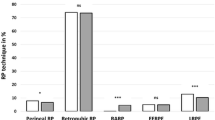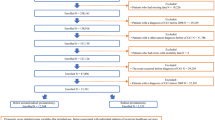Abstract
Objective
In this study, we document trends in radical prostatectomy (RP) employment in Germany during the period 2005–2012 and compare the morbidity of open (ORP), laparoscopic and robotic-assisted RP based on nationwide administrative data of Allgemeine Ortskrankenkassen (AOK) German local healthcare funds.
Materials and methods
Administrative claims data of all AOK patients subjected to RP during 2005–2012 (57,156 cases) were used to evaluate the employment of minimally invasive RP (MIRP) procedures, pelvic lymph node dissection (PLND) and nerve-sparing approaches during this period. In addition, data from the most recent three-year period of our dataset (2010–2012) were used to compare the morbidity among the different surgical approaches. Study end points comprised 30-day mortality, 30-day transfusion, 1-year reintervention and 30-day adverse events, as well as 1-year overall complications.
Results
A 20 % reduction in RP utilization from 2007 to 2012 was documented. ORP remained the predominant RP approach in Germany. MIRP approaches carried a lower risk of 30-day transfusions, 1-year reinterventions and 1-year overall complications than ORP when adjusting for confounding factors. PLND was associated with an increased risk of complications, while age in the highest quintile and the presence of comorbidities were independent risk factors for morbidity and mortality. Lack of pathological data was the main limitation of the study.
Conclusions
RP utilization in Germany is dropping, but the use of MIRP has risen steadily during the years 2005–2012, which is expected to have a positive impact on the morbidity of the operation.

Similar content being viewed by others
References
Federal Ministry of Health (2013) Statutory health insurance statistics KM1/13: Annual average 2012. https://www.bundesgesundheitsministerium.de/fileadmin/dateien/Downloads/Statistiken/GKV/Mitglieder_Versicherte/KM1_JD_2012.pdf. Accessed 31 July 2015
Federal Statistical Office (2014) Statistical yearbook 2014. https://www.destatis.de/DE/Publikationen/StatistischesJahrbuch/StatistischesJahrbuch.html. Accessed 31 July 2015
Bundesamt Statistisches (2015) Daten der Jahr 2005–2012 nach §21 KHEntgG des Statistischen Bundesamtes. Statistisches Bundesamt, Wiesbaden
WIdO (2014) Entwicklung des Leistungsbereichs “Radikale Prostatektomie (RPE) bei Prostatakarzinom”: Abschlussbericht. http://qualitaetssicherung-mit-routinedaten.de/methoden/bereiche/index.html. Accessed 31 July 2015
Elixhauser A, Steiner C, Harris DR, Coffey RM (1998) Comorbidity measures for use with administrative data. Med Care 36(1):8–27
Cornu JN, Terrasa JB, Cussenot O, Haab F, Lukacs B (2012) Evolution of the landscape of surgical management of prostate cancer in France: the case of radicalprostatectomy. Eur Urol 62(4):735–736
Etzioni R, Mucci L, Chen S, Johansson JE, Fall K, Adami HO (2012) Increasing use of radical prostatectomy for nonlethal prostate cancer in Sweden. Clin Cancer Res 18(24):6742–6747
Rebillard X, Grosclaude P, Lebret T et al (2010) Projected incidence and mortality from urologic cancer in France in 2010. Prog Urol 20:S211–S214
Laird A, Fowler S, Good DW et al (2015) Contemporary practice and technique-related outcomes for radical prostatectomy in the UK: a report of national outcomes. BJU Int 115(5):753–763
Kowalczyk KJ, Levy JM, Caplan CF et al (2012) Temporal national trends of minimally invasive and retropubic radical prostatectomy outcomes from 2003 to 2007: results from the 100 % Medicare sample. Eur Urol 61(4):803–809
Parsons JK, Messer K, Palazzi K, Stroup S, Chang D (2014) Diffusion of surgical innovations, patient safety and minimally invasive radical prostatectomy. JAMA Surg 149(8):845–851
Feifer AH, Elkin EB, Lowrance WT et al (2011) Temporal trends and predictors of pelvic lymph node dissection in open or minimally invasive radical prostatectomy. Cancer 117(17):3933–3942
Huland H, Graefen M (2015) Changing trends in surgical management of prostate cancer: the end of overtreatment? Eur Urol 68(2):175–178
Ward JF, Slezak JM, Blute ML, Bergstralh EJ, Zincke H (2005) Radical prostatectomy for clinically advanced (CT3) prostate cancer since the advent of prostate-specific antigen testing: 15-year outcome. BJU Int 95:751–756
Agarwal PK, Sammon J, Bhandari A et al (2011) Safety profile of robot-assisted radical prostatectomy: a standardized report of complications in 3317 patients. Eur Urol 59(5):684–698
De Carlo F, Celestino F, Verri C et al (2014) Retropubic, laparoscopic, and robot-assisted radical prostatectomy: surgical, oncological, and functional outcomes: a systematic review. Urol Int 93(4):373–383
Coelho RF, Rocco B, Patel MB et al (2010) Retropubic, laparoscopic, and robot-assisted radical prostatectomy: a critical review of outcomes reported by high-volume centers. J Endourol 24(12):2003–2015
Author contribution
Stolzenburg was involved in protocol/project development/data analysis/study supervision. Kyriazis contributed to data analysis/manuscript writing/editing. Fahlenbrach, Gilfrich, Günster, Jeschke, Popken, Weißbach, von Zastrow, Hanna Leicht were involved in data collection/data analysis/manuscript editing.
Author information
Authors and Affiliations
Corresponding author
Ethics declarations
Conflict of interest
All authors have no conflict of interest to declare.
Rights and permissions
About this article
Cite this article
Stolzenburg, J.U., Kyriazis, I., Fahlenbrach, C. et al. National trends and differences in morbidity among surgical approaches for radical prostatectomy in Germany. World J Urol 34, 1515–1520 (2016). https://doi.org/10.1007/s00345-016-1813-7
Received:
Accepted:
Published:
Issue Date:
DOI: https://doi.org/10.1007/s00345-016-1813-7




